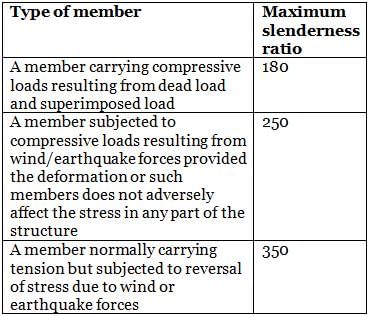Test: Compression Members- 2 - Civil Engineering (CE) MCQ
10 Questions MCQ Test GATE Civil Engineering (CE) 2026 Mock Test Series - Test: Compression Members- 2
Which one of the following values represents the maximum slenderness ratio of any connection member which normally acts as a tie in a roof truss but can be subjected to possible reversal of stresses from the action of wind or seismic force?
The permissible bending stress in slab base is (fy = 250 N/mm2)
Consider the following statements for the design of a laced column:
1) In a bolted construction, the minimum width of the lacing bar shall be three times the nominal diameter of the end bolt.
2) The thickness of the flat of a single lacing system shall be not less than one-fortieth of its effective length
3) The angle of inclination of the lacing bar should be less than 40° with the axis of the built-up column
4) The lacing shall be designed for a transverse shear of 2.5% of the axial load on the column
Which of the above statements are correct?
Slenderness ratio for single angle single riveted strut should be less than
In ISMC 400 channels placed back to back at a spacing of 26 cm carry an axial load of 160 tonnes. The lacing system should be designed to resist a transverse shear of
The thickness of lacing bars for single lacing, system should not be less than
where l = length between the inner end of connections.
Permitted maximum slenderness ratio of a steel, column under dead load and live load is
Two ISMC 400 are placed back to back at a spacing of 300 mm and carry an axial ioad.of 160 kN. As per IS : 800 1984 its lacing system should be designed to resist a transverse shear of
Slenderness ratio of the splices for compression members is
|
33 docs|291 tests
|




 for single lacing
for single lacing  for double lacing riveted or welded at intersection.
for double lacing riveted or welded at intersection.

















